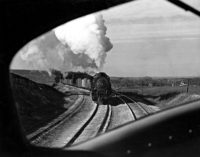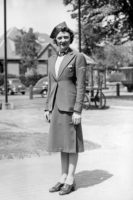
Santa Fe Railway, Matfield Green, Kansas, circa 1940. Photograph by John Barriger.
John Barriger ranks among the twentieth century’s most significant railroad photography leaders. He rose to national prominence in the railroad world during the late 1920s and the early 1930s, first as a bureaucrat and, after World War II, as president of several rail lines. He became active as a photographer in the 1930s and carried on for six-decades to showcase the ailments and realities of American life and culture through the rail industry.
John Walker Barriger III (1899-1976) achieved high acclaim for his leadership of federal transportation agencies and of railroads themselves. Unusual for a top executive, one of Barriger chief tools in decision-making and prophecies was none other than photographs he took himself of railroad infrastructure. The pictures helped him pinpoint ailments along the railroads, both in general and specifically. He achieved great success in curing the industry from the 1920s into the 1970s that he became known as “the doctor of sick railroads.”
Barriger rose to national prominence in the railroad world during the late 1920s and the early 1930s, first as a bureaucrat and, after World War II (1941-45), as president for four different lines: the Monon, Pittsburgh & Lake Erie, Missouri-Kansas-Texas, and the Boston & Maine. He was most active as a photographer in the 1930s when he led the railroad division of the Reconstruction Finance Corporation, though he continued taking pictures throughout a six-decade career. The over 60,000 diagnostic railroad photographs he took across the span of his career can he considered more then just x-rays of the industry and tools for research. They can also be considered art.
This exhibition is no longer in circulation.

Dorthy Loseke, a registered nurse, served as a “courier nurse” on the Santa Fe Railway’s Scout passenger train in Wellington, Kansas, 1940. Photograph by John Barriger.
